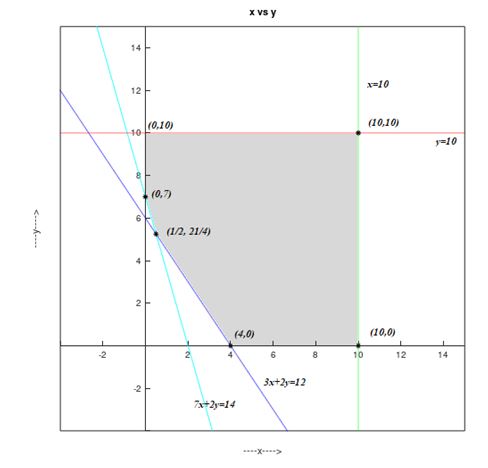
Production Scheduling In a factory, machine 1 produces 8-inch (in.) pliers at the rate of 60 units per hour (h) and 6-in. pliers at the rate of 70 units/h. Machine 2 produces 8-in. pliers at the rate of 40 units/h and 6-in. pliers at the rate of 20 units/h. It costs to operate machine 1, and machine 2 costs to operate. The production schedule requires that at least 240 units of 8-in. pliers and at least 140 units of 6-in. pliers be produced during each 10-h day. Which combination of machines will cost the least money to operate?
To solve: The given linear programming problem.
Answer to Problem 24AYU
Solution:
The minimum expense is when Machine 1 is operated for 30 minutes and machine 2 is operated for 5 hours and 15 minutes.
Explanation of Solution
Given:
| Machine | 8 inch pliers | 6 inch pliers | Cost of operation |
| 1 | 60 units/hour | 70 units/hour | |
| 2 | 40 units/hour | 20 units/hour |
In 10 hours of production schedule requires atleast, 240 units of 8 inch pliers and 140 units of 6 inch pliers.
Calculation:
Begin by assigning symbols for the two variables.
Number of hours Machine 1 operates.
Number of hours Machine 2 operates.
a. If is the total cost of operating the two machines, then
The goal is to minimize subject to certain constraints on and . Because and represents time, the only meaningful values of and are non-negative.
Therefore, .
From the given data we get
Therefore, the linear programming problem may be stated as
Minimize,
Subject to
The graph of the constraints is illustrated in the figure below.

| Corner points are | Value of objective function |
| 300 | |
| 210 | |
| 200 | |
| 500 | |
| 800 |
The minimum expense is when Machine 1 is operated for 30 minutes and machine 2 is operated for 5 hours and 15 minutes.
Chapter 11 Solutions
Precalculus
Additional Math Textbook Solutions
Elementary Statistics (13th Edition)
Algebra and Trigonometry (6th Edition)
College Algebra with Modeling & Visualization (5th Edition)
Thinking Mathematically (6th Edition)
Elementary Statistics: Picturing the World (7th Edition)
A Problem Solving Approach To Mathematics For Elementary School Teachers (13th Edition)
- Evaluate F. dr where F(x, y, z) = (2yz cos(xyz), 2xzcos(xyz), 2xy cos(xyz)) and C is the line π 1 1 segment starting at the point (8, ' and ending at the point (3, 2 3'6arrow_forwardCan you help me find the result of an integral + a 炉[メをメ +炉なarrow_forward2 a Can you help me find the result of an integral a 아 x² dxarrow_forward
- Please help me with this question as I want to know how can I perform the partial fraction decompostion on this alebgric equation to find the time-domain of y(t)arrow_forwardPlease help me with this question as I want to know how can I perform the partial fraction on this alebgric equation to find the time-domain of y(t)arrow_forwardEvaluate F³ - dr where ♬ = (4z, -4y, x), and C' is given by (t) = (sin(t), t, cos(t)), 0≤t≤ñ .arrow_forward
- Mid-Term Review Find the formula for (f + g)(x). f(x) = x² - 10x + 25 and g(x) = x² - 10x + 24 (f + g) (x) = [ 2 ]x² X + DELL Skip Sarrow_forwardCalculus III May I please have some elaborations on Example 2 part a? Thank you.arrow_forward1. A bicyclist is riding their bike along the Chicago Lakefront Trail. The velocity (in feet per second) of the bicyclist is recorded below. Use (a) Simpson's Rule, and (b) the Trapezoidal Rule to estimate the total distance the bicyclist traveled during the 8-second period. t 0 2 4 6 8 V 10 15 12 10 16 2. Find the midpoint rule approximation for (a) n = 4 +5 x²dx using n subintervals. 1° 2 (b) n = 8 36 32 28 36 32 28 24 24 20 20 16 16 12 8- 4 1 2 3 4 5 6 12 8 4 1 2 3 4 5 6arrow_forward
 Calculus: Early TranscendentalsCalculusISBN:9781285741550Author:James StewartPublisher:Cengage Learning
Calculus: Early TranscendentalsCalculusISBN:9781285741550Author:James StewartPublisher:Cengage Learning Thomas' Calculus (14th Edition)CalculusISBN:9780134438986Author:Joel R. Hass, Christopher E. Heil, Maurice D. WeirPublisher:PEARSON
Thomas' Calculus (14th Edition)CalculusISBN:9780134438986Author:Joel R. Hass, Christopher E. Heil, Maurice D. WeirPublisher:PEARSON Calculus: Early Transcendentals (3rd Edition)CalculusISBN:9780134763644Author:William L. Briggs, Lyle Cochran, Bernard Gillett, Eric SchulzPublisher:PEARSON
Calculus: Early Transcendentals (3rd Edition)CalculusISBN:9780134763644Author:William L. Briggs, Lyle Cochran, Bernard Gillett, Eric SchulzPublisher:PEARSON Calculus: Early TranscendentalsCalculusISBN:9781319050740Author:Jon Rogawski, Colin Adams, Robert FranzosaPublisher:W. H. Freeman
Calculus: Early TranscendentalsCalculusISBN:9781319050740Author:Jon Rogawski, Colin Adams, Robert FranzosaPublisher:W. H. Freeman
 Calculus: Early Transcendental FunctionsCalculusISBN:9781337552516Author:Ron Larson, Bruce H. EdwardsPublisher:Cengage Learning
Calculus: Early Transcendental FunctionsCalculusISBN:9781337552516Author:Ron Larson, Bruce H. EdwardsPublisher:Cengage Learning





